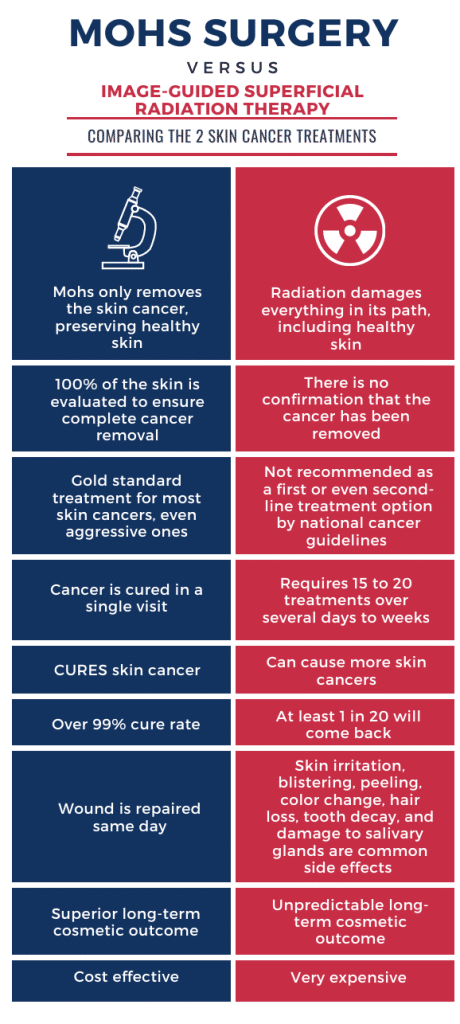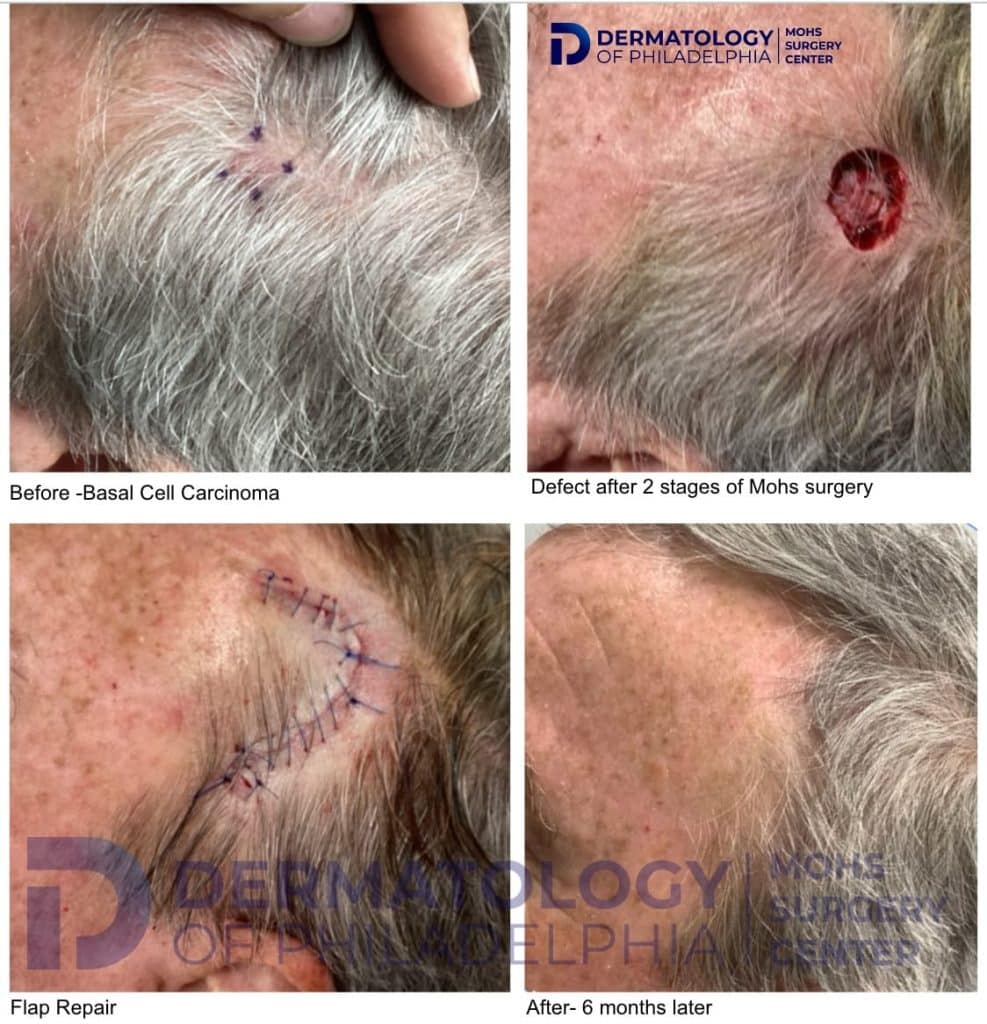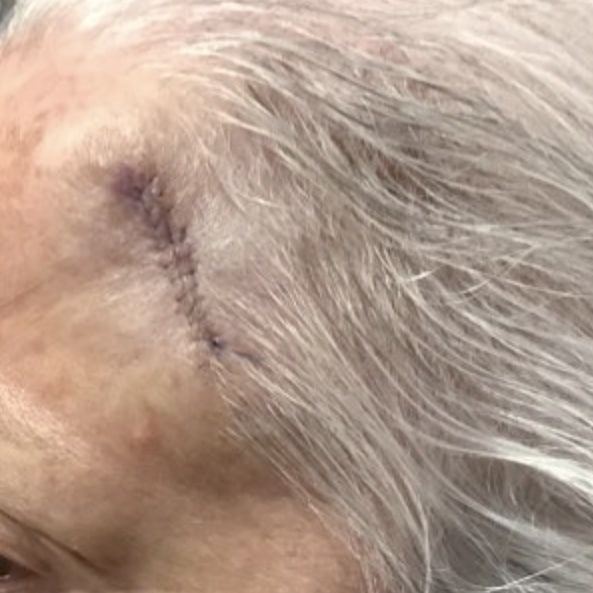When it comes to treating most basal cell carcinomas and squamous cell carcinomas, the most common types of skin cancer, Mohs surgery is indisputably the most effective and “gold standard” treatment. But many people are tempted to forgo Mohs surgery for another treatment called superficial radiation therapy. It’s like an X-ray or radiation treatment for skin cancer. Unlike surgery, which is completed in 1 day, radiation treatment requires around 20 radiation sessions to finish a treatment course.
Mohs surgery is more effective in the long run, requires fewer visits, is more cost-effective, and has much more research supporting its safety and efficacy compared to superficial radiation therapy. Most skin cancer experts recommend considering superficial radiation only in rare and special circumstances if Mohs surgery isn’t an option. To learn more about what to expect with Mohs surgery including the risks and benefits of Mohs surgery, click here: (https://dermofphilly.com/mohs-surgery/)
How Do You Know If Radiation Therapy is Right for You?
Your skin cancer diagnosis is unique- there is not a single article, website, online testimonial from a doctor or a patient, or YouTube video that will be able to choose the right method for you.
To help guide patients debating between Mohs surgery and radiation, the National Comprehensive Cancer Network (NCCN) says surgery is the mainstay of treatment for skin cancer, but radiation therapy can be considered for “nonsurgical candidates.”
If you really are not a surgical candidate or if surgery would be disfiguring or result in loss of function, radiation can be considered. True non-surgical candidates are very rare– Mohs surgery is an outpatient procedure performed under local anesthesia that is almost always very well tolerated with excellent cosmetically sensitive reconstruction options.
The best way to treat your skin cancer should be determined by working with a dermatologist who is an expert in skin cancer with extensive experience in treating all kinds of skin cancer- small, big, on the face, off the face, common, rare.
Mohs surgery and superficial radiation are just two of the ways you can treat skin cancer. There are other FDA approved treatments for skin cancer including medical management with topical creams.
And scientists across the world are researching targeted and personalized treatments for skin cancer that don’t involve surgery, including some forms of immunotherapy that can treat squamous cell carcinoma and melanoma. There are situations now where patients can be successfully treated non-surgically that just a few years ago would have required major surgery.
Mohs surgeons frequently work with radiation oncologists for certain types of skin cancer, especially squamous cell carcinomas that involve or grow around nerves in the skin. In addition there are certain times when a Mohs surgeon advises that even after the skin cancer has been removed with precision during Mohs, it may be prudent to also treat the area with radiation therapy to lower the chance of recurrence.
Which is more effective at curing skin cancer- Mohs surgery or superficial radiation?
Overall Mohs surgery has about a 99% cure rate. With Mohs surgery, the chance of the cancer coming back within 5 years is extremely low, around 1-2%.
By comparison, the Journal of the National Comprehensive Cancer Network (NCCN) reports the 5-year recurrence for basal cell carcinoma is around 9%. That means that almost 1 in 10 basal cell carcinomas treated with radiation are expected to recur. Looking at both basal cell carcinoma and squamous cell carcinoma, the published recurrence rates after superficial radiation range from 4.2-15.8%.
How do you know if all the cancer is removed?
With radiation, the area with skin cancer and the surrounding skin is treated with radiation beams, but there is never proof that the skin cancer has been completely eradicated.
By comparison, during Mohs surgery, the Mohs surgeon examines 100% of the outer margin and 100% of the deep margin of the skin removed to make sure that every margin is completely free of cancer. Every single margin is meticulously checked for cancer. This happens under the microscope and is why Mohs surgery can span hours or even a full day. But the plus side of going through the precise techniques used in Mohs surgery is definitive proof all the cancer has been removed.
This precise margin examination only happens with Mohs surgery- it does not happen with surgical excisions performed without the Mohs technique and, again, there is no margin whatsoever examined with any kind of radiation treatment.
Because there is never proof that all of the skin cancer has been removed with radiation, the treated site should be monitored carefully by your doctor to spot skin cancer at the first sign of it returning.

What are the side effects of superficial radiation therapy?
Side effects range from things like itching, burning, crusting, and scaling to more serious things like permanent hair loss, ulceration, infection, bleeding, and scarring.
Radiation dermatitis, also known as a radiation burn, can occur after superficial radiation therapy for skin cancer.
Radiated skin can also be more sensitive to touch or pressure, especially during the treatment course. Skin discoloration during and after radiation therapy can happen including darkening of the skin, lightening of the skin, and the development of a new blood vessel network in and around the treated area.
Which Type of Treatment Leaves a Scar?
All treatments for skin cancer leave behind some sign that some kind of treatment occurred. Having “no scar” is simply not a reasonable expectation after a cancer diagnosis, especially if you are seeking the most effective cure rate for cancer.
You may come across online testimonials where even experts say things like “with superficial radiation therapy instead of replacing cancer with a scar, we are replacing cancer with healthy tissue….anyone would rather have healthy skin!” Unfortunately, many experts believe this is a misleading message that doesn’t give the full picture of what happens when you treat skin with radiation.
Like all treatments, there are side effects and risks with radiation therapy. And radiation therapy leaves behind a scar- just a different kind of scar than with surgery.
Superficial radiation therapy beams target everything in its path, including healthy skin. This can create a radiation scar. Radiated skin can scar with light patches, thin skin with a shiny appearance, and burn-like scars with a growth of blood vessels within and around the scar. These, like surgical scars, are permanent scars.
In the hands of a fellowship-trained and board-certified Mohs surgeon it is very possible and highly likely that in the long run you will have a cosmetically elegant scar that is barely perceptible- even by you.

Is There a Dark Side of Radiation Therapy?
Many people ultimately decide that radiation therapy is the best choice to treat their skin cancer.
Unfortunately, a dark side of radiation treatment is an increased risk of developing another skin cancer in the treated area. So while radiation can treat skin cancer, it can also CAUSE skin cancer. In fact, one of the special indications to choose Mohs surgery is when a patient develops skin cancer in an area of skin that was previously treated with radiation. These are more difficult to treat skin cancers and have a higher chance of recurrence once they do appear.
Where Do I Go from Here?
If you find yourself in a situation where you are developing multiple skin cancers, make sure you find a skin cancer expert who is knowledgeable about all methods of treating skin cancer. Patients who develop more than 5 skin cancers per year, often need a multipronged approach to treating their skin cancer including a combination of creams, injections, Mohs surgery, regular surgery, radiation, and medications that can lower the rate of developing skin cancers.
And if you are considering radiation therapy because you’re tired of surgery, you owe it to yourself to seek advice from a well-rounded cutaneous oncologist who can help you navigate difficult choices on the best way to proceed.





